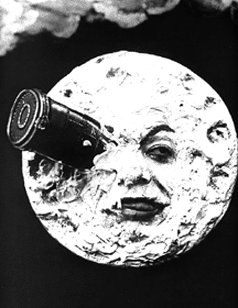In the fall of 1896, early filmmaker and performance magician, Georges Méliès, was making a short movie on a Paris street. He developed a problem with his camera’s film feed, which had become stuck for a few seconds. Méliès (1861-1938) didn’t think much about it, until he developed the film. Due to the camera’s stoppage, the figures were distorted, popped in and out of frame, or simply disappeared altogether. This occurrence would forever change how films were made, and it opened up a brand new avenue of creative potential in early cinema.

Méliès was a Parisian showman, illusionist, and filmmaker. He owned the famous Robert-Houdin Theater in Paris, which had once been home to the father of modern magic, Jean-Eugène Robert-Houdin. On December 28, 1895, the Lumière brothers first demonstrated their Cinématographe in Paris at the Salon Indien du Grand Café, and Méliès was there for it. The Lumières were unwilling to sell their camera, so Méliès researched the technology and built his own, initially playing others’ films in his theater. The
first one was shown on April 4, 1896. Méliès was immediately taken with the medium and soon started filming and showing his own movies, which generally featured him in some way.
Méliès is likely most famous for his A Trip to the Moon (Le Voyage dans le lune, 1902), with its iconic “rocket-in the-eye” image. However, as a pioneer of special effects, Méliès’ experimentation with film allowed him to develop the first split screen that had Méliès interacting with himself (Un Homme de tête, 1898), the first double exposure (La caverne Maudite, 1898), and the first image dissolve (Cendrillon, 1899). According to the Internet Movie Data Base, Méliès has 552 titles to his credit.

The projector developed by the Lumières and replicated by Méliès had its technological roots in the eighteenth-century “solar microscope” that was used to project microscopic objects for an audience using the sun as a light source.
The magician Katterfelto (see page) used one to project “insects,” or microorganisms, to his audience’s horror. The solar microscope technology was shortly followed by the development of the “magic lantern,” which used increasingly
sophisticated light sources and glass slides with images painted upon them for “Fantasmagorie” shows. Magic Lanterns fell out of use with the advent of film projection.



Do Your Own Research
LEARN MORE

Primary Sources
Secondary Sources
Tom Gunning, “‘Primitive’ Cinema: A Frame-up? Or the Trick's on Us,” Cinema Journal, 28/2 (Winter, 1989), 3-12.
Matthew Solomon, Disappearing Tricks: Silent Film, Houdini, and the New Magic of the Twentieth Century (Champaign-Urbana: University of Illinois, Press, 2010).

